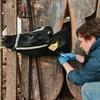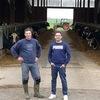Explore all the information on
Dairy cattle - Management practices
Welcome to the page about Dairy cattle - Management practices of Engormix; a source of knowledge on Dairy cattle - Management practices.
Israel is located in the eastern basin of the Mediterranean Sea and is characterized by a subtropical climate. Summer lasts from June to October and is characterized in most regions of the country by high temperatures and humidity at all hours of the day, but no rain at all. The Israeli dairy industry has about 120,000 cows that produce close to 1.5 billion liters per year. The annual milk yield per cow is the highest in the world and stood at more than 12,000 liters in 2021. The...
Comments : 2
Recommendations: 1
This article is written at the end of July, the hottest part of the year here in Israel, when every return home from abroad is first accompanied by going to the fridge to drink a lot of cold water. I decided that this is the right time to write about the importance of water in the dairy farm, especially for those located in warm regions. The issue of water in the dairy farm is an essential element in achieving milk yield, production efficiency and high profitability, especially in the warm...
Comments : 2
Recommendations: 4
.jpg&w=3840&q=75)

Turn Up the Dial on Rumen Efficiency with NitroShure™ Precision Release Nitrogen
Suggested link
...
Comments : 0
Recommendations: 0
An increase in the velocity of air, at a temperature lower than the surface temperature of the animal, has the potential to increase the sensible heat loss of the animal. An augmentation in air velocity will shift the upper critical temperature upwards. An effective ventilation system to reduce heat stress should emphasize the production of high air speed as much as the commonly accepted goal of reducing ambient temperature. Increasing the air velocity lowers the effective temperature...
Comments : 1
Recommendations: 1
Introduction Lucerne is the main grazed forage of Argentina. However, there is a large yield and consumption gap on most dairy and beef farms. Jáuregui et al. (2019) indicated that < 5 t ha -1 are consumed on average on dairy farms. There is potential to close the gap by increased grazing frequency, particularly during periods of high growth such as spring (Jáuregui et al., 2022). However, the long-term effects of such management on lucerne persistence...
Comments : 1
Recommendations: 0
Dairy farmers are always looking for ways to boost efficiency in their operation. This especially holds true in the milking parlor. Installing new technology or hiring an extra hand is one way to increase efficiency, but it can also cost producers a pretty penny. Think about the environment of the parlor itself. Is your parlor a place...
Comments : 0
Recommendations: 0
Calves can maintain body temperature within a certain range of temperatures called the thermoneutral zone without the need for additional energy. When temperatures drop below the critical low temperature (lower of 10°C), calves must use stored body energy to support essential body functions and maintain their body temperature. ...
Comments : 0
Recommendations: 1
Introduction The major challenge in livestock farming worldwide is to increase and improve production while limiting environmental impact and competition for resources for human consumption. Ruminants are key to food security as they convert forages, not directly usable by monogastric animals and humans, into animal products for human food. They supply 51% of all protein with respectively 67% and 33% from milk and meat (Gerber et al., 2013). However, ruminant livestock...
Comments : 0
Recommendations: 0
.jpg&w=3840&q=75)

Turn Up the Dial on Rumen Efficiency with NitroShure™ Precision Release Nitrogen
Suggested link
...
Comments : 0
Recommendations: 0
...
Comments : 0
Recommendations: 0
INTRODUCTION Despite the growing concern for animal welfare, pain control in farm animals is still neglected (CANOZZI et al., 2020; HEWSON et al., 2007; HUXLEY & WHAY, 2006; LORENA et al., 2013). Until recently, this was partly due to the lack of precise instruments to assess pain (DOCKWEILER et al., 2013). In cattle, several zootechnical practices culminate in acute perioperative pain that can become chronic or neuropathic if preventive measures are not taken. The most...
Comments : 0
Recommendations: 0
Increasing the level of nutrition provided to dairy calves in the first weeks of life has resulted in several benefits such as decreased morbidity and mortality, faster recovery from disease, decreased age at first calving, improved mammary development, and increased milk production as an adult. What causes abomasal...
Comments : 0
Recommendations: 0
Calves require supplemental water early in life to support hydration, health, early grain intake, rumen development, and body growth. Supplying body water by feeding milk or milk substitute is not enough to optimize these performance factors. The rumen needs a separate source of pure water to feed the fermentation process that makes the rumen grow. ...
Comments : 0
Recommendations: 0
In a previous article published some years ago here, dealing with cooling project that I accompanied in northern Mexico, I described the results from the first and second years of its implementation. The data were presented in a limited way, for a series of dairy farms belonging to the "Alpura" dairy cooperative, located in the warm regions of northern Mexico and characterized by long summer months, with extreme heat load conditions for dairy cows. These farms are mainly large and...
Comments : 3
Recommendations: 2
.jpg&w=3840&q=75)

Turn Up the Dial on Rumen Efficiency with NitroShure™ Precision Release Nitrogen
Suggested link
Introduction In India, current milk production is 163.7 million tones (DADF Annual Report, 2016-2017) Health and welfare of dairy animals is vital to ensure their longevity and long term productivity, to intensify the production, animal production systems are becoming highly mechanized. In recent years, efforts have been undertaken to improve welfare and overall-health of dairy cows by providing a higher level of comfort regarding the housing environment. Housing system...
Comments : 8
Recommendations: 9
In a previous article that I recently published, I dealt with the importance of drinking water and water for cooling the cows, when dealing with the summer heat. In this article, I would like to deal with another factor that I see as very important in the above-mentioned confrontation, and it is shade, or in other words, preventing the exposure of cows to direct and indirect solar radiation in the summer. Why is it important to protect cows from solar radiation in the summer? To...
Comments : 1
Recommendations: 1
I would like to open a discussion on the top breed(s) of goat for dairy production suitable for hot/dry climates.
Moreover, how to best source these breeds to guarantee the right genes for dairy production....
Comments : 0
Recommendations: 0
Introduction Milk production losses in summer months are generally related to the negative impact of heat stress on cows in lactation and late gestation stages. In the last 4 decades, several studies have been carried out in different parts of the world to mitigate heat through the implementation of cooling systems. In recently published articles, the different benefits achieved by properly implementing these means were presented. Among these benefits can be seen those related...
Comments : 0
Recommendations: 1
Introduction Automation can be defined as technology that allows for a process to be performed automatically, with minimal human input. The adoption and use of automation in the dairy industry has grown dramatically in the past decade. Much of the automation adopted has been associated with milking and other aspects of barn management. There is also growing interest and adoption of automation in feeding of dairy cattle. Specifically, the use of automation in feeding of lactating...
Comments : 0
Recommendations: 3
Introduction Biological rhythms are repeating patterns that are driven by time-keeping mechanisms within the animal and are adaptive as they coordinate physiology and metabolism with the external environment. The dairy cow has a well-recognized natural daily pattern of feed intake and milk synthesis and an annual rhythm of milk composition, but regulation of these rhythms has not been well described in the literature or well considered in current dairy management. We commonly...
Comments : 0
Recommendations: 1







.jpg&w=3840&q=75)













